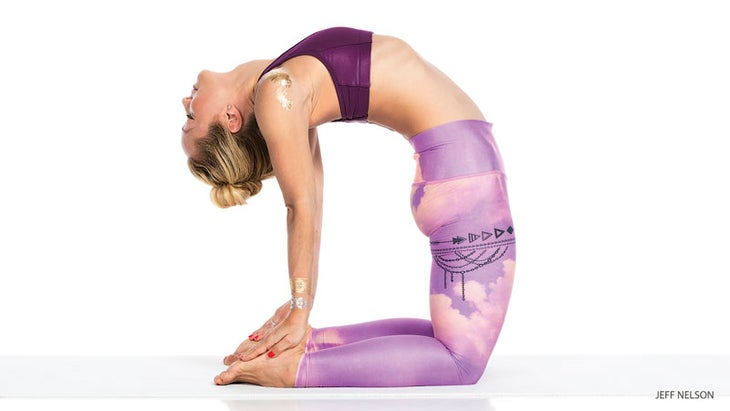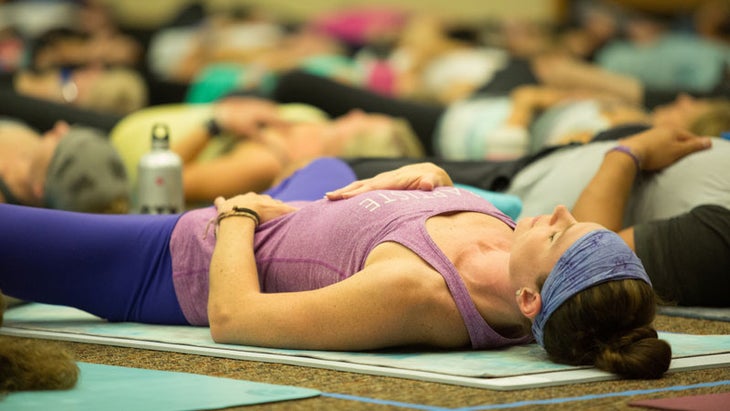Heading out the door? Read this article on the new Outside+ app available now on iOS devices for members! Download the app.
At some point along your path as a yogi, you’re likely to hear breathing instructions like these: Now lie on your back, and we’ll do diaphragmatic breathing. Breathe into your belly, letting it rise on the inhalation and fall on the exhalation. Don’t let your rib cage lift. If your rib cage moves up and down but your abdomen does not, you’re not using your diaphragm. Belly breathing is the deepest breathing.
Those instructions are riddled with myths and half-truths. But even though they are anatomically inaccurate, they are not wrong. The practice they describe, known as diaphragmatic belly breathing, is perfectly legitimate. It’s true that emphasizing abdominal movement while keeping the rib cage relatively immobile engages your diaphragm and creates a breath that feels wonderfully calming. But it’s not true that allowing your ribs to lift or keeping your abdomen still always creates shallow, nondiaphragmatic breathing.
See also Anatomy 101: How to Tap the Real Power of Your Breath
Diaphragmatic Breathing vs. Belly Breathing
It’s understandable where this myth came from. Many of us come to yoga as “chest breathers,” meaning we’re accustomed to an unhealthy pattern of initiating the breath from the chest, which can be agitating. When you fall into a pattern of isolated upper-chest breathing, you grossly overuse muscles in the neck and upper body (known as the accessory muscles of inspiration) and underuse the diaphragm. During heavy exercise and in emergency situations, you need these accessory muscles: They kick in to supplement the diaphragm’s action by moving the rib cage up and down more vigorously, helping to bring more air to the lungs. But unlike the diaphragm, which is designed to work indefinitely, the accessory muscles tire more easily, and overusing them will eventually leave you feeling fatigued and anxious. All of this makes upper-chest breathing exhausting, rather than restorative, in everyday situations. It’s no wonder, then, that most yogis avoid it.
One type of breathing, however, strongly activates the upper torso yet creates a full, deep pattern of breath. We’ll call it diaphragmatic rib cage breathing, because it uses the diaphragm to lift and spread the ribs on inhalation and ease them back down on exhalation, while keeping the belly relatively still. Belly breathing, which massages the abdominal organs more than rib cage breathing, often feels more natural and soothing and is easier to learn. It’s an excellent introduction to breath awareness for beginners and a good way to teach people to calm themselves quickly, especially during an anxiety attack, because it strongly discourages use of the accessory muscles of inspiration. Diaphragmatic rib cage breathing is harder to learn, and it can stray into inefficient, anxiety-promoting upper-chest breathing if done incorrectly. But if performed properly, it is calming and much more powerful for strengthening the diaphragm, deepening the inhalation, stretching the lungs, and more effectively aerating all parts of the lungs. It can even improve your backbends.
See also 5 Pranayama Techniques With the Power to Transform Your Practice—& Your Life
Understanding Diaphragmatic Rib Cage Breathing
To understand the action behind diaphragmatic rib cage breathing, it’s helpful to know how the rib cage, abdomen, and diaphragm work together to move air into and out of your lungs. Think of your torso as a partly flattened cylinder divided into upper and lower sections. The upper section, whose walls are formed mainly by the rib cage, is called the thoracic cavity. It is almost entirely filled by the lungs, but it also contains the heart. The lower section, whose walls are formed mainly by the abdominal muscles, is called the abdominal cavity. It contains all the other organs of the trunk (liver, stomach, and so on), bathed in fluid. The divider between these two cavities is the diaphragm, a roughly dome-shaped sheet of muscle and tendon that serves as both the ceiling of the abdominal cavity and the floor of the thoracic cavity.
The top of the diaphragm’s dome, which is known as the central tendon, is made of tough, fibrous tissue. To get a sense of where it is, touch your fingertips to the middle of your sternum. They are now approximately level with the highest point of the dome, which lies deep inside your chest behind your breastbone.
The walls of the diaphragm’s dome are made of muscle tissue that connects the top of the dome to the base of the rib cage. To feel where the bottom edge of your diaphragm is attached to your rib cage, move your fingers to the notch at the base of your sternum. From there, trace the lowermost border of your rib cage down, around the side of your body, and as far back toward your spine as you can feel it. Your diaphragm is attached to the inside of your rib cage along this path.
Whenever you inhale, your brain signals your diaphragm muscle to contract. In diaphragmatic belly breathing, this contraction of the diaphragm’s muscular walls pulls the top of the dome down toward its base at the bottom of the rib cage. When the dome moves down, it pushes on the organs and fluid in the abdominal cavity, causing the belly to bulge outward, in much the same way that a water balloon will bulge out if you set it on a table and press down on it. This requires relaxed abdominal muscles.
The lungs sit on top of the diaphragm and cling to its upper surface. So as the diaphragm descends, it pulls down on the lungs, stretching the lungs longer and creating extra space inside them. Outside air naturally rushes into the lungs to fill the extra space, resulting in what we know as inhalation. When the inbreath is complete, your brain stops signaling your diaphragm to contract, the muscle relaxes, and all the tissues that it moved during inhalation spring back to their original position, forcing air out of the lungs and creating an exhalation.
Diaphragmatic rib cage breathing is quite different, however. At the beginning of an inhalation, you gently contract the front abdominal muscles to prevent the belly from puffing out. This action pushes the abdominal contents inward and upward against the bottom of the diaphragm; therefore, the top of the dome cannot descend easily, the way it did in belly breathing. The top of the dome, now supported from below, acts as a relatively stable platform. And the forceful contraction of the diaphragm’s muscular walls pulls the base of the rib cage up toward it (although the top of the dome does move down a little).
The lower border of the rib cage lifts the most because the diaphragm is attached directly to it. As the ribs lift, they also swing outward and away from the body, expanding the lungs from side to side and from front to back, making the thoracic cavity wider and deeper.
The sides of the lungs cling to the inner walls of this cavity, so they stretch outward too. Extra airspace is created inside them, causing inhalation. Relaxing the diaphragm lowers the rib cage and raises the top of the dome, returning the lungs to their former size, forcing air out and producing exhalation.
How Diaphragmatic Rib Cage Breathing Can Enhance Your Asana Practice

Some of the breath-control skills you learn in diaphragmatic rib cage breathing can enhance your asana practice. In particular, you can use the exhalation phase of this breath to improve your backbends. Because they require a continuous lift of the sternum, backbends lock your upper ribs in the “inhale” position while keeping your abdominal muscles long and relatively relaxed. This makes it difficult to exhale, because you cannot push air out of your lungs by lowering your upper ribs or by strongly contracting your abdominal muscles. The less stale air you breathe out, the less fresh air you breathe in, so you end up with too little oxygen and too much carbon dioxide in the body. That’s one reason people tire easily in backbends.
There is a way to expel more air: Relax your diaphragm completely so that it no longer pulls upward on your lower six ribs, and use accessory muscles to maintain the lift of the upper chest. This will cause the lower ribs to descend and move toward the midline of your body. The “down and in” movement of the ribs will push air out of the lower lobes of your lungs, making extra room for fresh air on the next inhalation. By truly relaxing your diaphragm at the end of each exhalation and by moving your lower ribs down and in as you do in diaphragmatic rib cage breathing, you can breathe more deeply in the pose without compromising its form. Consciously breathing this way during backbends will make them much more comfortable, and you will be able to stay in them longer.
Before trying this technique, first become adept at supine diaphragmatic rib cage breathing, paying attention to the process of letting a little additional air out of your lungs at the end of your exhalation by releasing your lower ribs toward one another without contracting your abdominal muscles.
Next, do the same thing while standing in Tadasana (Mountain Pose), with your back against a wall and your hands on your lower ribs. Then, staying in Tadasana at the wall, lift your arms overhead, touching your hands to the wall if possible. Again practice extending your exhalations at the end by dropping your lower ribs down and inward without lowering your arms or breastbone, and without contracting your abdominal muscles. This takes some practice.
Finally, when you feel ready, get into a backbend that’s suitable to your level of practice—for example, Ustrasana (Camel Pose) for beginners or Urdhva Dhanurasana (Upward Bow Pose) for intermediate and advanced students—and use the same technique to consciously prolong each exhalation. You may be surprised by how much easier the pose becomes.
Improving your backbends is only the beginning. Breathing lies at the heart of yoga, and the diaphragm lies at the heart of breathing. Learn to use it skillfully, and it will bring new freedom to every part of your practice.
Practice: Diaphragmatic Rib Cage Breathing Deconstructed

To experience diaphragmatic rib cage breathing, lie in Savasana (Corpse Pose) and place your palms on your lower ribs so that the tips of your middle fingers touch each other about two inches below your sternum at the end of exhalation. As you begin to inhale, subtly tighten your front abdominal muscles just enough to prevent your belly from rising. Continue inhaling without allowing your belly to rise or fall; your diaphragm will draw your lower ribs up and apart, so your middle fingertips will separate.
On exhalation keep your abdomen completely level as you allow your ribs to return to their starting position; the middle fingertips will touch as before. At the end of exhalation, release a little extra air, without forcing, by consciously allowing your lowermost ribs to swing down and in a little more, while fully relaxing your abdomen.
It’s easy to go astray in diaphragmatic rib cage breathing. Remain calm and comfortable at all times; never force, and if you feel strain or agitation, stop and let the breath come back to normal. To steady your mind, direct your gaze unwaveringly downward under closed eyelids during both inhalation and exhalation. If you find that you cannot maintain this breathing with relative ease, stop, rest, and return to the practice at a later time.
See also The Science of Breathing
About Our Writer
Roger Cole, PhD, is an Iyengar Yoga teacher and sleep research scientist in Del Mar, California. For more information, visit http://www.rogercoleyoga.com.